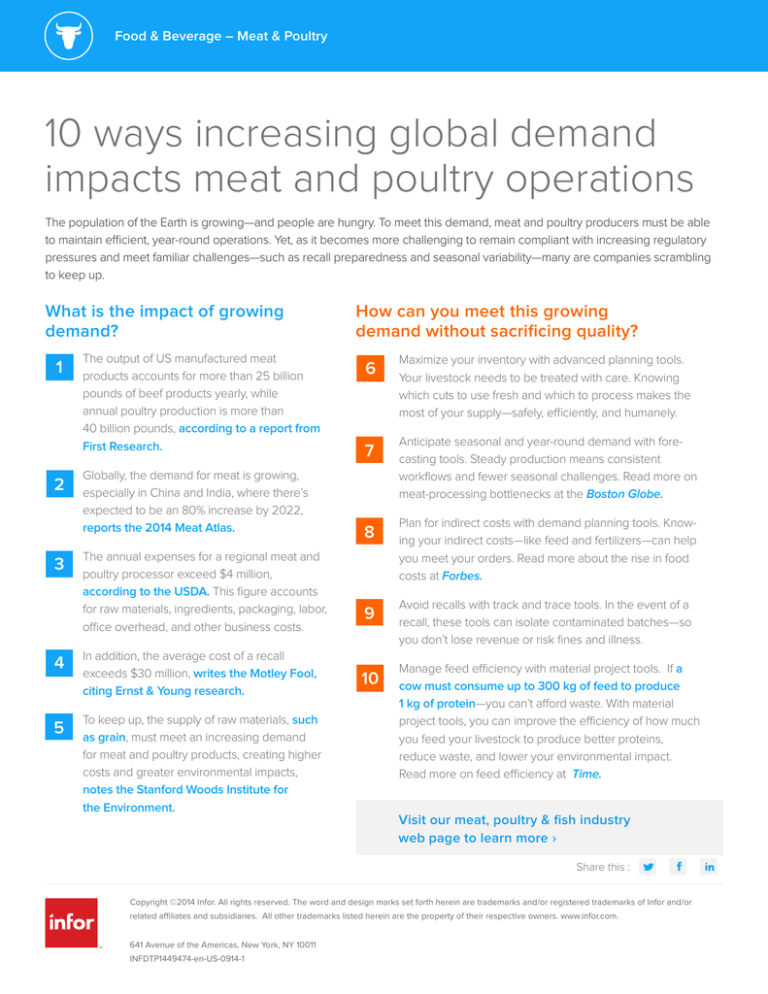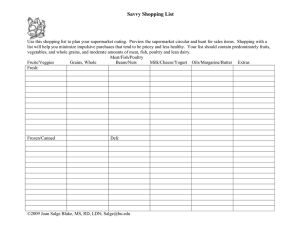
Food & Beverage – Meat & Poultry
Manufacturing
10 ways increasing global demand
impacts meat and poultry operations
The population of the Earth is growing—and people are hungry. To meet this demand, meat and poultry producers must be able
to maintain efficient, year-round operations. Yet, as it becomes more challenging to remain compliant with increasing regulatory
pressures and meet familiar challenges—such as recall preparedness and seasonal variability—many are companies scrambling
to keep up.
What is the impact of growing
demand?
1
2
3
The output of US manufactured meat
products accounts for more than 25 billion
pounds of beef products yearly, while
annual poultry production is more than
40 billion pounds, according to a report from
First Research.
Globally, the demand for meat is growing,
especially in China and India, where there’s
expected to be an 80% increase by 2022,
reports the 2014 Meat Atlas.
The annual expenses for a regional meat and
poultry processor exceed $4 million,
according to the USDA. This figure accounts
for raw materials, ingredients, packaging, labor,
office overhead, and other business costs.
4
In addition, the average cost of a recall
exceeds $30 million, writes the Motley Fool,
citing Ernst & Young research.
5
To keep up, the supply of raw materials, such
as grain, must meet an increasing demand
for meat and poultry products, creating higher
costs and greater environmental impacts,
notes the Stanford Woods Institute for
the Environment.
How can you meet this growing
demand without sacrificing quality?
6
7
8
9
10
Maximize your inventory with advanced planning tools.
Your livestock needs to be treated with care. Knowing
which cuts to use fresh and which to process makes the
most of your supply—safely, efficiently, and humanely.
Anticipate seasonal and year-round demand with forecasting tools. Steady production means consistent
workflows and fewer seasonal challenges. Read more on
meat-processing bottlenecks at the Boston Globe.
Plan for indirect costs with demand planning tools. Knowing your indirect costs—like feed and fertilizers—can help
you meet your orders. Read more about the rise in food
costs at Forbes.
Avoid recalls with track and trace tools. In the event of a
recall, these tools can isolate contaminated batches—so
you don’t lose revenue or risk fines and illness.
Manage feed efficiency with material project tools. If a
cow must consume up to 300 kg of feed to produce
1 kg of protein—you can’t afford waste. With material
project tools, you can improve the efficiency of how much
you feed your livestock to produce better proteins,
reduce waste, and lower your environmental impact.
Read more on feed efficiency at Time.
Visit our meat, poultry & fish industry
web page to learn more ›
Share this :
Copyright ©2014 Infor. All rights reserved. The word and design marks set forth herein are trademarks and/or registered trademarks of Infor and/or
related affiliates and subsidiaries. All other trademarks listed herein are the property of their respective owners. www.infor.com.
641 Avenue of the Americas, New York, NY 10011
INFDTP1449474-en-US-0914-1



